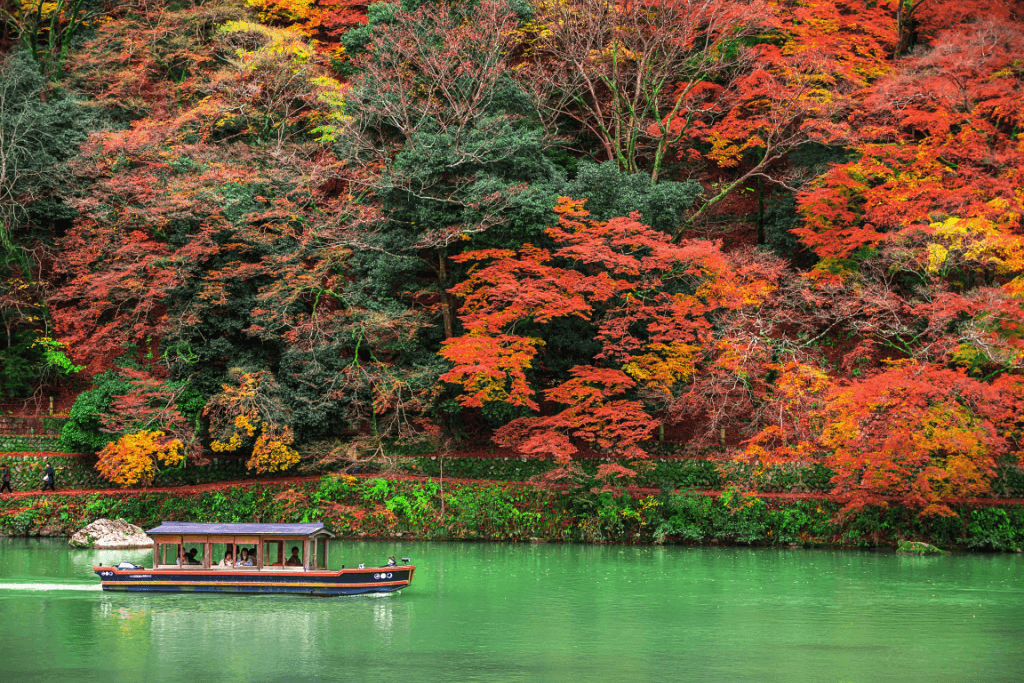Arashiyama is a city that is about thirty minutes from Kyoto Station. Like Kyoto, it has a rich history and various experiences and attractions. The most popular attractions are Sagano Bamboo Forest, Okochi Sanso, Iwatayama Monkey Park, Togetsukyo Bridge, and Matsunotaisha. Let’s look closer at the area and see what you can discover there!
Table of Contents
ToggleWhat’s Arashiyama like?
Arashiyama in Japanese translates into “storm mountain.” As a city, Arashiyama encompasses a few mountains on the east and west sides of the Katsura River. On the west side are three mountains: Matsuo, Arashiyama, and Karasugadake, collectively known as the Arashiyama Sanzan. Sanzan means “three mountains.” In spring, summer, and fall, locals typically climb these mountains daily.
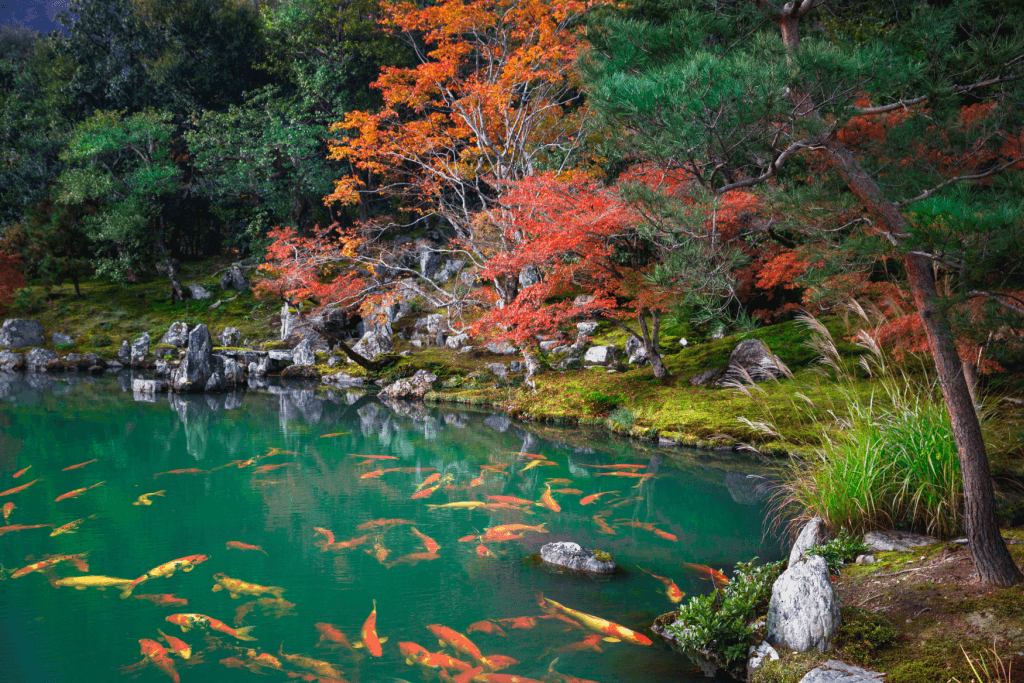
On the east side, there are the Ogura Mountains and Kameyama Mountains. The entire area, including the foothills, is generally called Arashiyama. A popular way to get across the river to visit both mountain areas is walking across the Togetsukyo Bridge. The area north of the Togetsukyo Bridge is the Sagano area, famous for the Sagano Bamboo Forest. It is popular for tourists to explore the Sagano area by bicycle or by rickshaw.
Although Arashiyama is a small town, many places remain to visit. If you plan on visiting, you should plan for a full-day trip to get the most out of the area. Like Kyoto, you can stay at modern hotels or traditional ryokans.
Sagano Bamboo Forest in Arashiyama
One of the most Instagramable locations in Japan is the Sagano Bamboo Forest. While it can be jam-packed during peak seasons, it is known for being a very tranquil location. Japan’s Ministry of the Environment designated the location’s aural pleasures as one of the country’s “100 Soundscapes of Japan.” To experience the true tranquility of the forest, you should visit in the off seasons or early in the morning.
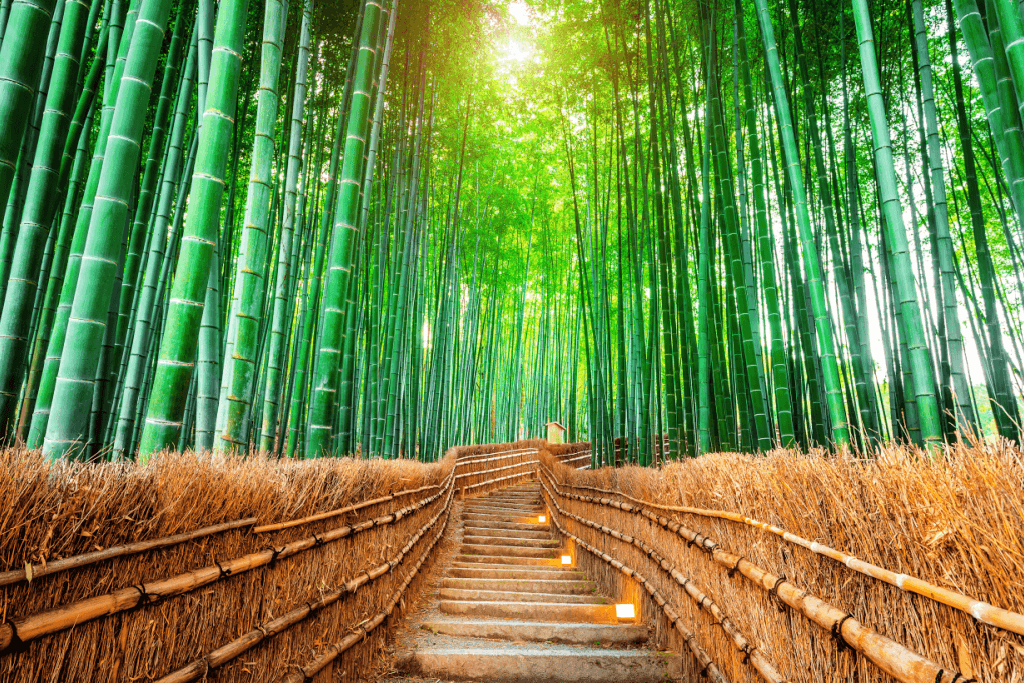
The forest covers approximately 6.2 sq mi (16 sq km). However, the path from end to end of the forest is about 500m, about a 10-30 minute walk. The length of your visit largely depends on how fast you walk, the crowd’s size, and how many pictures you take! You can also visit the nearby Tenryu-ji Temple while you’re in the area!
Sagano Bamboo Forest is open 24/7, and admission is free. It takes about twenty minutes from Kyoto Station to use the San-in Line Rapid train to get to Saga Arashiyama Station. From there, it is about a ten-minute walk to the forest.
Okochi Sanso Villa
Okochi Sanso Villa is on the foothills of Mt. Ogura at the end of the Sagano Bamboo Forest. It was previously the estate of the famed film actor Okochi Denjiro (1898-1962). The villa is known for its beautiful gardens and fine Japanese architecture. The garden spreads across five acres (two hectares), so there’s much to explore. However, following the garden’s main path, indicated by arrows, you will see all the essential areas.
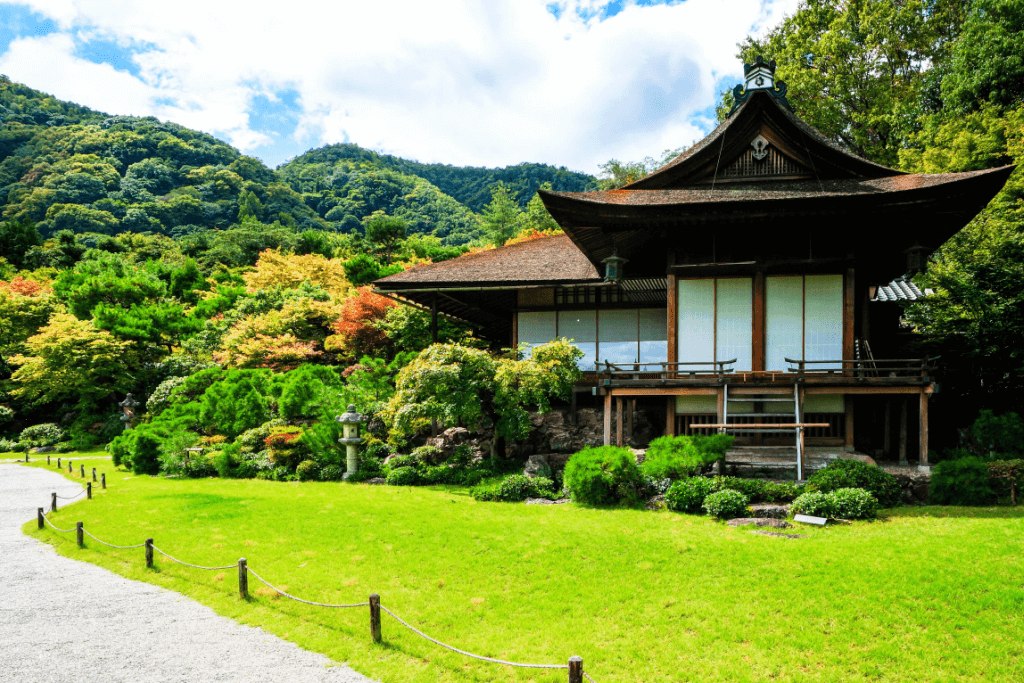
You can see a beautiful view of the Hozugawa River and the Arashiyama mountains along the main path. Other attractions include small temple halls, a miniature moss garden, and a traditional tea room. After strolling the garden, you can visit the Ōkochi Denjiro Museum. The museum is small, open-air, and dedicated to Ōkōchi Denjirō.
The villa is open daily from 9 a.m. to 5 pm; admission is 1000 yen. The admission fee includes tea and wagashi (traditional Japanese sweets). From Saga Arashiyama Station, it takes around 20 minutes by foot to get to the entrance (you can go through the forest).
Are you interested in enjoying more traditional snacks from places such as Kyoto? Check out Sakuraco! Sakuraco sends traditional Japanese snacks, sweets, teas, tableware, and more right to your door!
Iwatayama Monkey Park
If you can’t visit Nagano to see monkeys playing around, you can see some monkey fun in Arashiyama! The Iwatayama Monkey Park is located halfway up the Arashiyama mountain range. It has been famous as a habitat for Japanese macaques since its opening in 1956. The monkey park is also famous for the panoramic view of Kyoto City, where you can see Mt. Hiei, Mt. Kitayama, and Mt. Higashiyama.

The monkey park has a group of over one hundred and twenty macaque monkeys residing there. All the monkeys are wild but are cared for and observed by the facility staff. At the monkey park, you feed the monkeys inside a unique facility. Feeding the monkeys is a fun activity for all ages! However, please only buy one bag to prevent overfeeding–they only cost 100 yen!
From Saga-Arashiyama Station, Iwatayama Monkey Park is approximately a twenty-minute walk. It involves climbing one hundred and twenty steps stairs on a mild slope. The best time to visit is in spring or fall when the weather isn’t too humid or cold. The opening hours are 9 a.m. to 4 pm, and the admission fee is 550 yen.
Togetsukyo Bridge
Togetsukyo Bridge is a well-known landmark of Arashiyama. It is a 508-foot (155-meter) wooden bridge built across the Katsura River with concrete foundations. The original bridge was built in 836, but the current version debuted in 1934. In Japanese, togetsukyo means “moon crossing.” The name comes from a tale involving the Kamakura period Emperor Kameyama. The Emperor was on a boat during a party and thought the full moon was crossing the bridge.
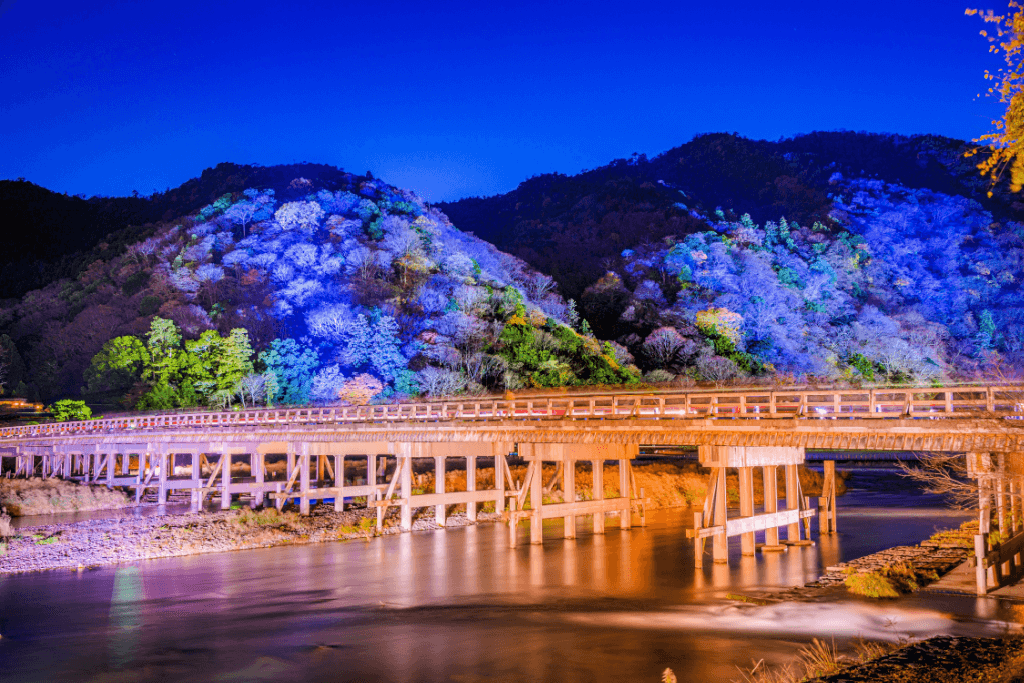
The bridge is a great place to get beautiful river views and mountainscapes. You can also watch people riding on rowboats and yakatabune boat cruises. The views are beautiful no matter the season, but fall is the best season to visit. During fall, the mountain leaves transform into a range of yellow, orange, and red colors, contrasting beautifully with the water. Togetsukyo Bridge is about a ten-minute walk from Saga-Arashiyama Station. It is open every day and is free to enter.
Matsunotaisha Shrine
Matsunotaisha Shrine lies on the foot of Matsuo Mountain, one of the oldest shrines in Kyoto. It was founded in 701 CE and is the guardian of sake brewing and fermentation. According to legend, it will always be the perfect brew if brewers use it for sake. In addition to being famous for its sake, it also has the “Three Shofuen Gardens.” The renowned landscape gardener Shigemori Mirei designed them. It was his final work, and he completed it back in 1975.
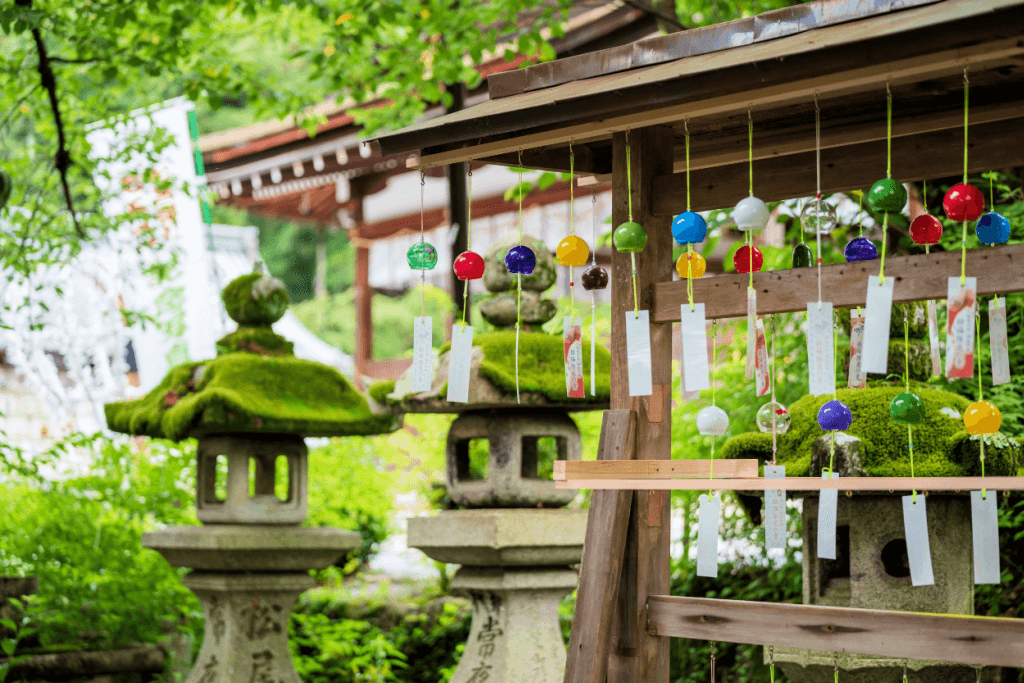
Each garden represents a different concept. The Joko Garden represents mountains, the Kyokusui Garden recreates an entertainment garden for aristocrats during the Heian period, and the Horai Garden is a Kamakura period-style depiction of the Chinese concept of paradise. Throughout these gardens, you will see small turtle statues that signify luck and longevity.
From Saga Arashiyama Station, Matsunotaisha Shrine is about a thirty-minute walk. However, you can visit it faster by transferring to the Hankyu line, taking the train to Matsuo-Taisha Station, and walking for two minutes. The shrine is open every day from 5 am to 6 pm. Admission is free.
Arashiyama is an idyllic destination for a day excursion while exploring the enchanting cities of Kyoto or Osaka. Nestled in the embrace of nature, this quaint town exudes a sense of serenity, framed by majestic mountains and exquisite gardens. A visit to Arashiyama offers a respite from the urban hustle, allowing you to immerse yourself in its tranquil surroundings. If you’re torn between these remarkable locations, share your preference in the comments below. We’re eager to hear your thoughts and travel aspirations!


